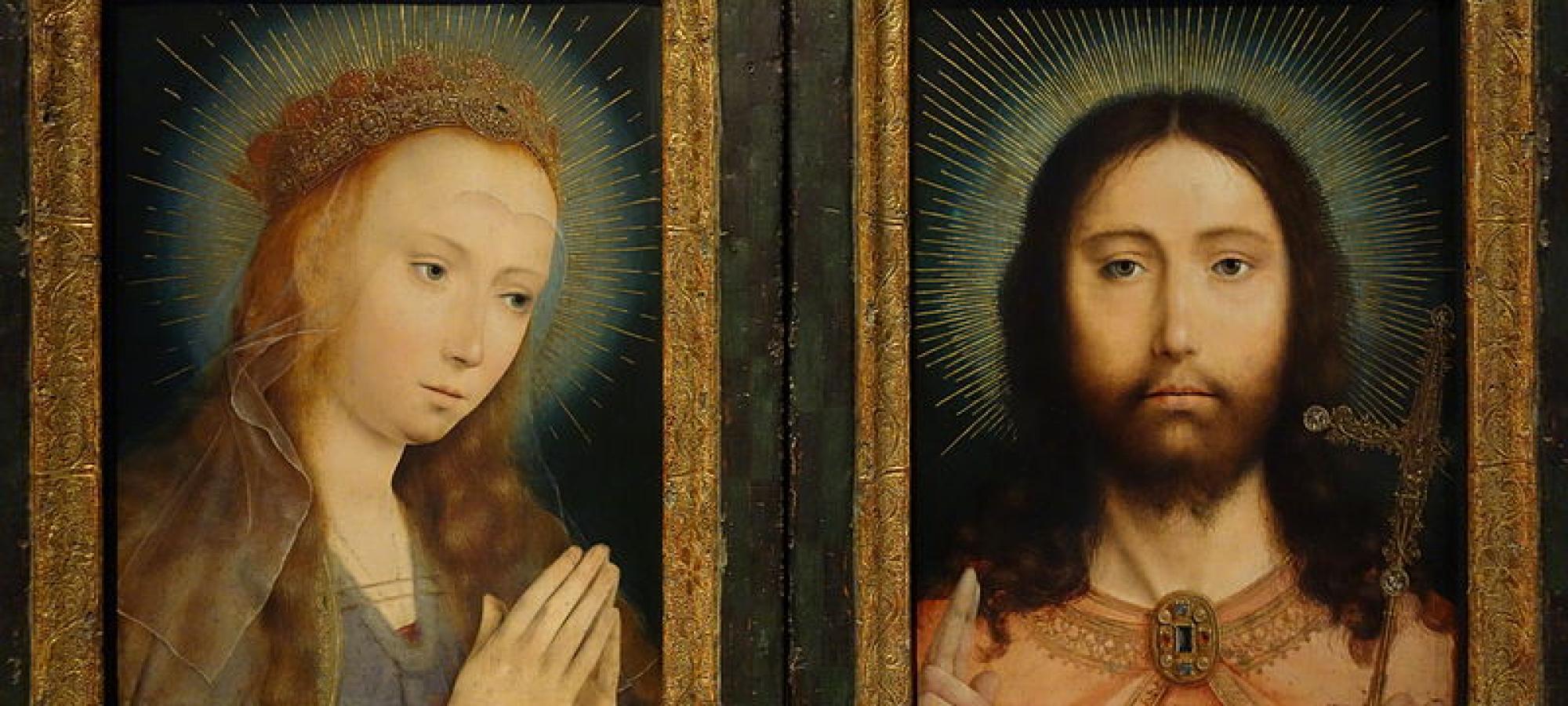
Quentin Massys: ‘Salvator Mundi’
The ‘Salvator Mundi’ is a representation of Christ in which he is shown full-face, staring intently out at the viewer, with his right hand raised in blessing, wearing royal robes, and often, with an orb surmounted by a cross in his left hand. As a type, it may have developed from earlier, Byzantine, ‘Christos Pantokrator’ image, which are similarly full-face, with a right hand making a gesture of blessing. In any case, it became popular among the painters, and presumably the purchasers, of late-medieval Flanders. Hans Memling, Jan van Eyck, and Albrecht Dürer all produced versions, as did Quentin Massys (1466–1530), who returned to the theme several times. The Campion Hall version is relatively unusual in being head and shoulders only: others, such as the version in the North Carolina Museum of Art or the one in the princely collection in Lichtenstein, are half-length, and portray Christ holding an orb in his left hand. However, the version in the Royal Museum of Fine Arts in Antwerp is, like ours, head and shoulders only. It forms half of a diptych, with the other half being a representation of the Virgin Mary at prayer, suggesting that ours may similarly have once been half of a pair.
Whereas other late-medieval depictions of Christ such as ‘Ecce Homo’ or ‘Man of Sorrows’ emphasise his physical sufferings and seek to arouse pity and compunction, the ‘Salvator Mundi’ type seeks to inspire awe. This is Christ envisaged as he might look when seated at the right hand of the Father. In the Campion Hall version, his garment is crimson, implying that it was died with kermes, which was the costliest of all medieval dyes. The neckline is elaborately embroidered with gold thread, gold ribbon, and pearls, with a gold brooch representing God the Father at the centre. Versions of this costume are standard for a Massys ‘Salvator Mundi’. Like most Netherlandic painters of his time, Massys was interested in the portrayal of jewels, gold, and rich textiles. Christ’s long wavy hair is painted with an artful naturalism, though the serene, full-cheeked face is an attempt to portray the supernatural rather than the natural.
Massys was born in Louvain, where he probably received his first training, but moved to Antwerp, where he became a member of the painters’ Guild of St Luke. He is considered one of Antwerp’s first important artists. Though his most famous paintings, such as ‘The Money Changer and his Wife’, are secular in theme, he also painted altarpieces and triptychs for churches, most notably for the Pieterskerk in Louvain. He also produced small paintings on religious themes for private patrons, and ‘Salvator Mundi’ is one such.
The Quentin Massys ‘Salvator Mundi’ has just returned to Campion Hall after conservation, since the panel on which it is painted was warping, and the paint surface had begun to crack. The conservator, Ruth Bubb, found that the wood of the panel, which is Baltic oak, contained a knot, which will have made the panel difficult to prepare. This may be the reason why the panel has tended to distort over time, cracking the surface paint layer. Repeated efforts have been made to flatten it out, which have caused problems of their own. Ms Bubb has been able to secure and consolidate the reverse of the painting in a way which should prevent further movement. The picture has also been cleaned, old varnish had been removed, and damaged areas retouched. Wax had been pressed into the crack in an attempt to stabilise it, and all this had also to be carefully removed.
The restoration work has revealed interesting details about the process of painting. The red was laid on first, because the blue background behind Christ goes over one edge, beside where Christ’s hand is raised in blessing. Blue came next, and was painted up to the outline of the head, under the hair. Then the mordant gilding of the halo, in thin, radiant lines, was laid on, and the figure was painted last.

